Cats are amazing creatures! They can jump vertically to the top of a refrigerator or fall and always land on their feet. They get themselves into some of the oddest positions because of their curiosity and always find a way out.
If you watch cats for any length of time while they’re playing, they’ll make you laugh for hours at some of the things they do. But – are cats ticklish?
Generally, you may not think so. We, humans, relate tickling to laughter, but cats don’t laugh. They may or may not make other noises, but determining if your cat is ticklish takes time, and it takes knowing your cat very well.
Ticklish Humans vs. Ticklish Cats

Gargalesis is a type of laughter-inducing tickling only experienced by humans and some primates, although recent studies show that rats experience this type of tickling too, but not felines.
Felines experience knismesis, a tickling sensation that humans also experience. Knismesis is an itchy and irritating type of tickle, like when something touches you lightly, and you brush it away.
We humans associate tickling with laughter. If you remember the child’s toy, “Tickle Me, Elmo,” when you tickled his belly, he’d squirm and laugh. Children loved that toy!
Most humans have sensitive or ticklish areas on their bodies too, most often their feet or their sides. When we’re tickled in those areas, we may squirm and laugh too, which is the gargalesis type of tickling.
Or, we may do what cats do, get irritated, and try to pull away. We may swat at whoever is tickling us to get them to stop. Cats do the same thing – without the laughter, which is the knismesis that cats experience.
Cat Reactions to Being Tickled
Just as no two humans are the same when reacting to tickles, no two cats are the same either. Although cats do not laugh, some may show signs of a sensitive, possibly ticklish area and react.
If you pet or tickle a cat in a sensitive spot under her ear, her back leg will twitch or jump.
You can get the same leg jump reaction if you tickle just the right spot on a cat’s belly.
If you have to use wipes or a cloth to clean their rear, they may start biting or licking their paws. Some cats will spread their toes if you tickle the bottom of the paws or between their toes.
Are Cats Paws Ticklish?
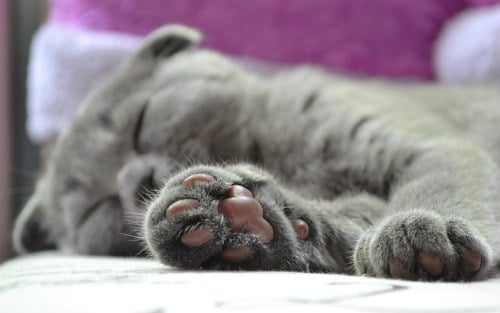
Feline paws are extra-sensitive, designed that way as a matter of survival, especially with outdoor cats. Cats’ paws sense ground vibrations, which alerts them of someone getting near. Quick on their feet by nature, they can sense if they need to run and hide.
Because their paws are so sensitive, even the softest touch may be ticklish to a cat. If you try to tickle her paws, especially underneath on her pads, she’ll either hiss and bat at you to stop, or she’ll always want you to pet her paws because she likes the sensation.
Other Sensitive or Ticklish Areas on a Cat
If your cat comes to you and nuzzles her head into your hands, she wants petting or tickling. Cats have some sensitive or ticklish areas on their bodies, and if you pay attention to those areas, they may respond by purring, growling, or making other odd noises that only cats can make.
Cats may even react physically by shivering or shaking their heads, tails, or lifting up their backs. If you touch certain areas and your cat hisses, swats at you, or bites, it may mean it’s time to stop. We, humans, can react the same way if we’re tickled too long in the same area.
Cats have rather sensitive areas; some are where they enjoy being tickled and others not so much. Your cat will let you know by her reaction to the touch.
Top of the Head, Chin, and Neck
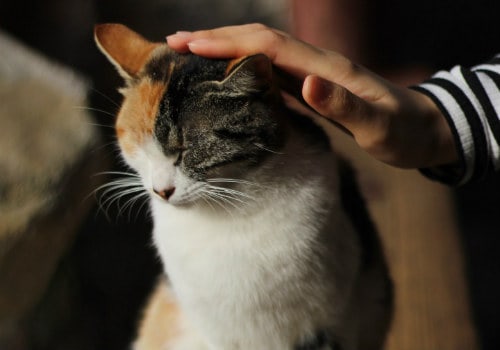
Many cats enjoy having the tops of their heads and their necks rubbed or tickled. They may even nudge at you to keep petting them if you stop. If you tickle her chin, she may react by lifting her head up higher so you can reach her neck.
The Front of the Body
When your cat wants you to pet her chest area, she may wander over and lift her head up. Not on her belly, but between her front legs, and she may lie down on her back, so you can easily reach that sensitive area.
A Cat’s Back
This particular area differs from cat to cat. Some cats enjoy having their backs rubbed. If you have a long-haired cat, she may enjoy the feel of a brush going along her back while being groomed.
Other cats don’t like being touched in this area at all and may use their rear paws to move your hand away. Use caution if your cat hasn’t been de-clawed.
A Cat’s Tail
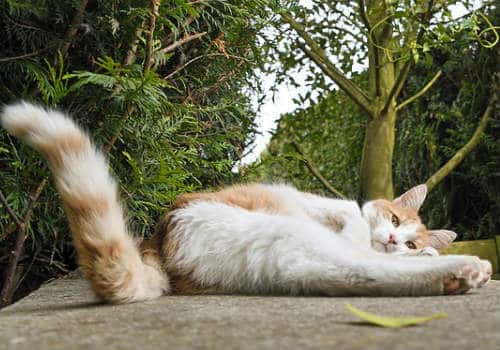
Depending on your cat, her tail may never stop moving. It’s always in motion, swaying back and forth like she’s using her tail to wave at you. The only time her tail is still is when she’s sleeping.
Some cats enjoy having their tails tickled or stroked. She may lie still and purr, knowing the touching her means she’s loved. Other cats may get up and move away because they don’t like the sensation of their tails being touched.
A Cat’s Stomach
Like humans, if we’re ticklish in our belly area, we hate it when people tickle us there. Instead of laughing, we may hit the other person or do anything to get away from being tickled.
Cats are the same way. Their bellies are extremely sensitive to the touch, and your cat might try to bite or claw at you if you try. Grooming a long-haired cat’s belly can be a chore, depending on the size of your cat.
To safely groom a cat’s belly, you may need to hold the cat in the air by the scruff of her neck so you can groom her belly. That’s about the only way to make sure that she can’t bite or claw at you.
Do Cats Laugh When They’re Tickled?
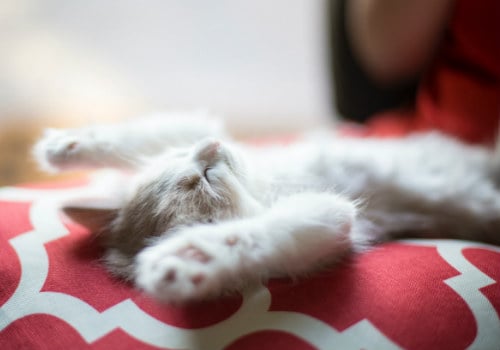
Unlike some other animals, cats don’t laugh. Instead, they make other noises to let us humans know that they’re happy, content, or annoyed.
They’ll purr or meow, hiss or scream depending on how they’re feeling.
They may meow when they want attention and then purr loudly when we’re tickling or touching them just the way they want.
If we don’t touch them in just the right place, they’ll use their paws or nip at you to let you know.
Once they’ve gotten the right amount of attention, they’ll simply get up and walk away.
Knowing When to Stop Tickling Your Cat
Cats have attitudes, for sure. They only want to be touched on their terms, not when you feel like it.
Your cat may jump up on your lap and snuggle in, but she may not want to be touched while she’s resting.
She may want to be tickled but only in certain areas and only for a certain amount of time.
Once you start petting or tickling your cat, change your motions and how you’re touching her.
If you don’t use varied tickling techniques, your cat may get bored or irritated, and she’ll let you know.
Get to Know Your Cat Before Tickling Her
Cats rarely show emotions like dogs or other animals. Felines by nature show no emotions as a matter of survival, especially in the wild.
However, if you pay close attention to your cat, you’ll learn to read her body language. You’ll get to know what areas are ticklish, if indeed any of them are, and when and how to touch them.
Finding Your Cat’s Tickle Spot (Video)
"In ancient times cats were worshipped as gods; they have not forgotten this."
-- Terry Pratchett





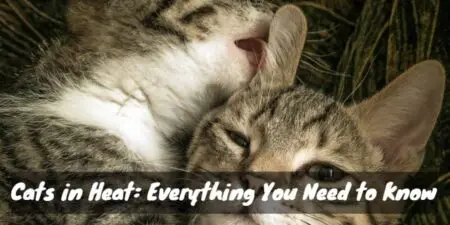
Why is the cat a “her” in the article?
Lol
Get a life, Norman
cats are females
A long way, you can finish step by step, and then you can’t reach without a foot
All great actions and thoughts have a negligible beginning.
Nobody cares Norman
And thus, everyone learned Norman sucks.
omg the best
Because ALL cats are girls. ;>